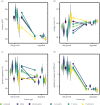Forest degradation limits the complementarity and quality of animal seed dispersal
- PMID: 35611541
- PMCID: PMC9130786
- DOI: 10.1098/rspb.2022.0391
Forest degradation limits the complementarity and quality of animal seed dispersal
Abstract
Forest degradation changes the structural heterogeneity of forests and species communities, with potential consequences for ecosystem functions including seed dispersal by frugivorous animals. While the quantity of seed dispersal may be robust towards forest degradation, changes in the effectiveness of seed dispersal through qualitative changes are poorly understood. Here, we carried out extensive field sampling on the structure of forest microhabitats, seed deposition sites and plant recruitment along three characteristics of forest microhabitats (canopy cover, ground vegetation and deadwood) in Europe's last lowland primeval forest (Białowieża, Poland). We then applied niche modelling to study forest degradation effects on multi-dimensional seed deposition by frugivores and recruitment of fleshy-fruited plants. Forest degradation was shown to (i) reduce the niche volume of forest microhabitat characteristics by half, (ii) homogenize the spatial seed deposition within and among frugivore species, and (iii) limit the regeneration of plants via changes in seed deposition and recruitment. Our study shows that the loss of frugivores in degraded forests is accompanied by a reduction in the complementarity and quality of seed dispersal by remaining frugivores. By contrast, structure-rich habitats, such as old-growth forests, safeguard the diversity of species interactions, forming the basis for high-quality ecosystem functions.
Keywords: environmental niche modelling; forest degradation; functional redundancy; old-growth forest; plant–frugivore interactions; seed dispersal effectiveness.
Conflict of interest statement
The authors declare no competing interests.
Figures




Similar articles
-
Unravelling seed dispersal through fragmented landscapes: Frugivore species operate unevenly as mobile links.Mol Ecol. 2017 Aug;26(16):4309-4321. doi: 10.1111/mec.14181. Epub 2017 Jun 9. Mol Ecol. 2017. PMID: 28503829
-
Frugivore-mediated seed dispersal in fragmented landscapes: Compositional and functional turnover from forest to matrix.Proc Natl Acad Sci U S A. 2023 Oct 31;120(44):e2302440120. doi: 10.1073/pnas.2302440120. Epub 2023 Oct 23. Proc Natl Acad Sci U S A. 2023. PMID: 37871198 Free PMC article.
-
Specialization and interaction strength in a tropical plant-frugivore network differ among forest strata.Ecology. 2011 Jan;92(1):26-36. doi: 10.1890/09-1842.1. Ecology. 2011. PMID: 21560673
-
[Effects of disturbances on animal-mediated seed dispersal effectiveness of forest plants: A review].Ying Yong Sheng Tai Xue Bao. 2017 May 18;28(5):1716-1726. doi: 10.13287/j.1001-9332.201705.033. Ying Yong Sheng Tai Xue Bao. 2017. PMID: 29745211 Review. Chinese.
-
Uniting niche differentiation and dispersal limitation predicts tropical forest succession.Trends Ecol Evol. 2021 Aug;36(8):700-708. doi: 10.1016/j.tree.2021.04.001. Epub 2021 May 7. Trends Ecol Evol. 2021. PMID: 33966918 Review.
Cited by
-
Common seed dispersers contribute most to the persistence of a fleshy-fruited tree.Commun Biol. 2023 Mar 27;6(1):330. doi: 10.1038/s42003-023-04647-y. Commun Biol. 2023. PMID: 36973362 Free PMC article.
References
-
- Mikusiński G, Bubnicki JW, Churski M, Czeszczewik D, Walankiewicz W, Kuijper DPJ. 2018. Is the impact of loggings in the last primeval lowland forest in Europe underestimated? The conservation issues of Białowieża Forest. Biol. Conserv. 227, 266-274. (10.1016/j.biocon.2018.09.001) - DOI
Publication types
MeSH terms
LinkOut - more resources
Full Text Sources
Other Literature Sources

